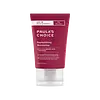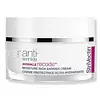Paula's Choice Skin Recovery Replenishing Moisturizer Versus StriVectin Wrinkle Recode Moisture Rich Barrier Cream
What's inside
What's inside
 Key Ingredients
Key Ingredients

 Benefits
Benefits

 Concerns
Concerns

 Ingredients Side-by-side
Ingredients Side-by-side

Water
Skin ConditioningCetearyl Ethylhexanoate
EmollientButylene Glycol
HumectantGlycereth-26
HumectantOenothera Biennis Oil
EmollientCetyl Alcohol
EmollientNeopentyl Glycol Diheptanoate
EmollientCyclopentasiloxane
EmollientStearic Acid
CleansingGlyceryl Stearate
EmollientPEG-100 Stearate
Glycerin
HumectantCyclohexasiloxane
EmollientDimethicone
EmollientPanthenol
Skin ConditioningPalmitoyl Tripeptide-1
Skin ConditioningPalmitoyl Tetrapeptide-7
Skin ConditioningSodium Hyaluronate
HumectantTocopheryl Linoleate
AntioxidantTocopheryl Acetate
AntioxidantTocopherol
AntioxidantMagnesium Ascorbyl Phosphate
AntioxidantAscorbyl Palmitate
AntioxidantDipotassium Glycyrrhizate
HumectantSodium PCA
HumectantAnthemis Nobilis Flower Extract
MaskingAloe Barbadensis Leaf Juice
Skin ConditioningSodium Ascorbyl Phosphate
AntioxidantLinoleic Acid
CleansingLinolenic Acid
CleansingPentaerythrityl Tetra-Di-T-Butyl Hydroxyhydrocinnamate
AntioxidantSaccharide Isomerate
HumectantHydroxypropyl Guar
Emulsion StabilisingAllantoin
Skin ConditioningRosa Moschata Seed Oil
EmollientPolysorbate 20
EmulsifyingCetyl Hydroxyethylcellulose
Emulsion StabilisingCarbomer
Emulsion StabilisingSodium Citrate
BufferingTrisodium EDTA
Batyl Alcohol
EmollientSodium Hydroxide
BufferingPhenoxyethanol
PreservativeChlorphenesin
AntimicrobialBenzoic Acid
MaskingSorbic Acid
PreservativeWater, Cetearyl Ethylhexanoate, Butylene Glycol, Glycereth-26, Oenothera Biennis Oil, Cetyl Alcohol, Neopentyl Glycol Diheptanoate, Cyclopentasiloxane, Stearic Acid, Glyceryl Stearate, PEG-100 Stearate, Glycerin, Cyclohexasiloxane, Dimethicone, Panthenol, Palmitoyl Tripeptide-1, Palmitoyl Tetrapeptide-7, Sodium Hyaluronate, Tocopheryl Linoleate, Tocopheryl Acetate, Tocopherol, Magnesium Ascorbyl Phosphate, Ascorbyl Palmitate, Dipotassium Glycyrrhizate, Sodium PCA, Anthemis Nobilis Flower Extract, Aloe Barbadensis Leaf Juice, Sodium Ascorbyl Phosphate, Linoleic Acid, Linolenic Acid, Pentaerythrityl Tetra-Di-T-Butyl Hydroxyhydrocinnamate, Saccharide Isomerate, Hydroxypropyl Guar, Allantoin, Rosa Moschata Seed Oil, Polysorbate 20, Cetyl Hydroxyethylcellulose, Carbomer, Sodium Citrate, Trisodium EDTA, Batyl Alcohol, Sodium Hydroxide, Phenoxyethanol, Chlorphenesin, Benzoic Acid, Sorbic Acid
Water
Skin ConditioningCaprylic/Capric/Myristic/Stearic Triglyceride
EmollientSqualane
EmollientButyrospermum Parkii Butter
Skin ConditioningMyristyl Nicotinate
Skin ConditioningGlycerin
HumectantPentaerythrityl Distearate
EmulsifyingDicaprylyl Ether
EmollientPropanediol
SolventDimethicone
EmollientCetyl Alcohol
EmollientGlyceryl Stearate
EmollientDi-C12-15 Alkyl Fumarate
EmollientPalmitoyl Tripeptide-5
Skin ConditioningPalmitoyl Tetrapeptide-72 Amide
Skin ConditioningCitrullus Lanatus Seed Oil
EmollientCucurbita Pepo Seed Extract
Skin ConditioningCucurbita Maxima Fruit Extract
Skin ConditioningCalendula Officinalis Flower Extract
MaskingBacillus Ferment
Skin ConditioningMelia Azadirachta Flower Extract
Skin ConditioningCorallina Officinalis Extract
Skin ConditioningCoccinia Indica Fruit Extract
Skin ConditioningBacillus/Sea Salt Ferment Filtrate
Skin ConditioningPhragmites Communis Extract
Skin ConditioningPoria Cocos Extract
Skin ConditioningMelia Azadirachta Leaf Extract
Skin ConditioningSolanum Melongena Fruit Extract
Skin ConditioningAloe Barbadensis Flower Extract
EmollientOcimum Sanctum Leaf Extract
Skin ConditioningCurcuma Longa Root Extract
MaskingPhytosteryl/Behenyl/Octyldodecyl Lauroyl Glutamate
Skin ConditioningNiacinamide
SmoothingAdenosine
Skin ConditioningCaprooyl Phytosphingosine
Skin ConditioningCaprooyl Sphingosine
Skin ConditioningHydrolyzed Hyaluronic Acid
HumectantCeramide NP
Skin ConditioningCeramide Ns
Skin ConditioningUrea
BufferingCeramide AP
Skin ConditioningCeramide EOP
Skin ConditioningCeramide Eos
Skin ConditioningAscorbyl Palmitate
AntioxidantCeteth-20
CleansingCeteareth-25
CleansingParfum
MaskingPolysilicone-11
Steareth-20
CleansingTrisodium Ethylenediamine Disuccinate
Cholesterol
EmollientCaprylyl Glycol
EmollientTocopherol
AntioxidantPEG-75 Stearate
Ethylhexylglycerin
Skin Conditioning1,2-Hexanediol
Skin ConditioningBehenic Acid
CleansingCaprylhydroxamic Acid
Sodium Polyacrylate
AbsorbentPhenoxyethanol
PreservativeCitric Acid
BufferingSodium Citrate
BufferingSodium Benzoate
MaskingPotassium Benzoate
PreservativePotassium Sorbate
PreservativeLimonene
PerfumingWater, Caprylic/Capric/Myristic/Stearic Triglyceride, Squalane, Butyrospermum Parkii Butter, Myristyl Nicotinate, Glycerin, Pentaerythrityl Distearate, Dicaprylyl Ether, Propanediol, Dimethicone, Cetyl Alcohol, Glyceryl Stearate, Di-C12-15 Alkyl Fumarate, Palmitoyl Tripeptide-5, Palmitoyl Tetrapeptide-72 Amide, Citrullus Lanatus Seed Oil, Cucurbita Pepo Seed Extract, Cucurbita Maxima Fruit Extract, Calendula Officinalis Flower Extract, Bacillus Ferment, Melia Azadirachta Flower Extract, Corallina Officinalis Extract, Coccinia Indica Fruit Extract, Bacillus/Sea Salt Ferment Filtrate, Phragmites Communis Extract, Poria Cocos Extract, Melia Azadirachta Leaf Extract, Solanum Melongena Fruit Extract, Aloe Barbadensis Flower Extract, Ocimum Sanctum Leaf Extract, Curcuma Longa Root Extract, Phytosteryl/Behenyl/Octyldodecyl Lauroyl Glutamate, Niacinamide, Adenosine, Caprooyl Phytosphingosine, Caprooyl Sphingosine, Hydrolyzed Hyaluronic Acid, Ceramide NP, Ceramide Ns, Urea, Ceramide AP, Ceramide EOP, Ceramide Eos, Ascorbyl Palmitate, Ceteth-20, Ceteareth-25, Parfum, Polysilicone-11, Steareth-20, Trisodium Ethylenediamine Disuccinate, Cholesterol, Caprylyl Glycol, Tocopherol, PEG-75 Stearate, Ethylhexylglycerin, 1,2-Hexanediol, Behenic Acid, Caprylhydroxamic Acid, Sodium Polyacrylate, Phenoxyethanol, Citric Acid, Sodium Citrate, Sodium Benzoate, Potassium Benzoate, Potassium Sorbate, Limonene
 Reviews
Reviews

Ingredients Explained
These ingredients are found in both products.
Ingredients higher up in an ingredient list are typically present in a larger amount.
Ascorbyl Palmitate is created by combining pure Vitamin C and palmitic acid. It is an antioxidant and helps reduce hyperpigmentation.
This ingredient is a more stable version of Vitamin C, meaning it does not disintegrate as quickly when exposed to sunlight. However, studies show it does not penetrate skin as well as pure Vitamin C.
Ascorbyl Palmitate is oil soluble.
Read more about other types of Vitamin C:
Learn more about Ascorbyl PalmitateCetyl Alcohol is a fatty alcohol. Fatty Alcohols are most often used as an emollient or to thicken a product.
Its main roles are:
Though it has "alcohol" in the name, it is not related to denatured alcohol or ethyl alcohol.
The FDA allows products labeled "alcohol-free" to have fatty alcohols.
Learn more about Cetyl AlcoholDimethicone is a type of synthetic silicone created from natural materials such as quartz.
What it does:
Dimethicone comes in different viscosities:
Depending on the viscosity, dimethicone has different properties.
Ingredients lists don't always show which type is used, so we recommend reaching out to the brand if you have questions about the viscosity.
This ingredient is unlikely to cause irritation because it does not get absorbed into skin. However, people with silicone allergies should be careful about using this ingredient.
Note: Dimethicone may contribute to pilling. This is because it is not oil or water soluble, so pilling may occur when layered with products. When mixed with heavy oils in a formula, the outcome is also quite greasy.
Learn more about DimethiconeGlycerin is already naturally found in your skin. It helps moisturize and protect your skin.
A study from 2016 found glycerin to be more effective as a humectant than AHAs and hyaluronic acid.
As a humectant, it helps the skin stay hydrated by pulling moisture to your skin. The low molecular weight of glycerin allows it to pull moisture into the deeper layers of your skin.
Hydrated skin improves your skin barrier; Your skin barrier helps protect against irritants and bacteria.
Glycerin has also been found to have antimicrobial and antiviral properties. Due to these properties, glycerin is often used in wound and burn treatments.
In cosmetics, glycerin is usually derived from plants such as soybean or palm. However, it can also be sourced from animals, such as tallow or animal fat.
This ingredient is organic, colorless, odorless, and non-toxic.
Glycerin is the name for this ingredient in American English. British English uses Glycerol/Glycerine.
Learn more about GlycerinGlyceryl Stearate is a mix of glycerin and stearic acid.
It is used to stabilize the mixing of water and oil ingredients. By preventing these ingredients from separating, it can help elongate shelf life. It can also help thicken the product's texture.
As an emollient, it helps soften skin and supports barrier-replenishing ingredients.
In cosmetics, Glyceryl Stearate is often made from vegetable oils or synthetically produced.
This ingredient may not be fungal-acne safe
Fun fact: The human body also creates Glyceryl Stearate naturally.
Learn more about Glyceryl StearatePhenoxyethanol is a preservative that has germicide, antimicrobial, and aromatic properties. Studies show that phenoxyethanol can prevent microbial growth. By itself, it has a scent that is similar to that of a rose.
It's often used in formulations along with Caprylyl Glycol to preserve the shelf life of products.
Sodium Citrate is the sodium salts of citric acid. In skincare, it is used to alter pH levels and acts as a preservative.
Its main functions are to maintain the pH of a product and neutralize metal ions.
The acidity of our skin is maintained by our glands and skin biome; normal pH level of skin is slightly acidic (~4.75-5.5).
Being slightly acidic allows our skin to create an "acid mantle". This acid mantle is a thin barrier that protects our skin from bacteria and contaminants.
Learn more about Sodium CitrateTocopherol (also known as Vitamin E) is a common antioxidant used to help protect the skin from free-radicals and strengthen the skin barrier. It's also fat soluble - this means our skin is great at absorbing it.
Vitamin E also helps keep your natural skin lipids healthy. Your lipid skin barrier naturally consists of lipids, ceramides, and fatty acids. Vitamin E offers extra protection for your skin’s lipid barrier, keeping your skin healthy and nourished.
Another benefit is a bit of UV protection. Vitamin E helps reduce the damage caused by UVB rays. (It should not replace your sunscreen). Combining it with Vitamin C can decrease sunburned cells and hyperpigmentation after UV exposure.
You might have noticed Vitamin E + C often paired together. This is because it is great at stabilizing Vitamin C. Using the two together helps increase the effectiveness of both ingredients.
There are often claims that Vitamin E can reduce/prevent scarring, but these claims haven't been confirmed by scientific research.
Learn more about TocopherolWater. It's the most common cosmetic ingredient of all. You'll usually see it at the top of ingredient lists, meaning that it makes up the largest part of the product.
So why is it so popular? Water most often acts as a solvent - this means that it helps dissolve other ingredients into the formulation.
You'll also recognize water as that liquid we all need to stay alive. If you see this, drink a glass of water. Stay hydrated!
Learn more about Water